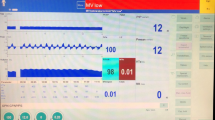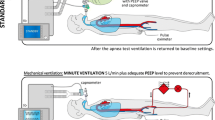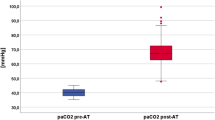Abstract
Background
Pneumothorax is an under-recognized complication of apnea testing performed as part of the neurological determination of death. It may result in hemodynamic instability or even cardiac arrest, compromising ability to declare brain death (BD) and viability of organs for transplantation. We report three cases of pneumothorax with apnea testing (PAT) and review the available literature of this phenomenon.
Methods
Series of three cases supplemented with a systematic review of literature (including discussion of apnea testing in major brain death guidelines).
Results
Two patients were diagnosed with PAT due to immediate hemodynamic compromise, while the third was diagnosed many hours after BD. An additional nine cases of PAT were found in the literature. Information regarding oxygen cannula diameter was available for nine patients (range 2.3–5.3 mm), and flow rate was available for ten patients (mean 11 L/min). Pneumothorax was treated to resolution in the majority of patients (n = 8), although only six completed apnea testing following diagnosis/treatment of pneumothorax and only three patients became organ donors afterward. Review of major BD guidelines showed that although use of low oxygen flow rate (usually ≤ 6 L/min) during apnea testing is suggested, the risk of PAT was explicitly mentioned in just one.
Conclusion
Development of PAT may adversely affect the process of BD determination and could limit the opportunity for organ donation. Each institution should have preventive measures in place.
Similar content being viewed by others
Avoid common mistakes on your manuscript.
Introduction
An apnea test is a critical component of the neurological determination of death. This requires disconnecting the patient from the ventilator while allowing hypercapnia to develop in the absence of spontaneous respirations. Hypoxemia and hypotension are well-recognized complications of apnea testing [1, 2]. Preventive strategies such as preoxygenation and insufflation of oxygen into the endotracheal tube (ETT) during testing have been suggested to decrease the incidence of hypoxemia [3]. If the administered gas inadequately diffuses out of the lungs, either due to occlusion of the ETT or from high rates of administration, then it can result in increased tension in the lungs even causing pneumothorax. The development of pneumothorax during apnea testing (PAT) is felt to be relatively rare, and many practitioners who perform apnea testing may not be aware of the possibility of this complication. However, its occurrence can be dramatic; it can result in acute hemodynamic or pulmonary instability and even cardiac arrest. This may lead to prematurely aborting the apnea test or critical hypoperfusion of viable organs that may be otherwise utilized for transplantation after death. Only prompt recognition that worsening cardiopulmonary dysfunction is actually due to PAT (requiring decompression), and not simply a normal consequence of apnea testing, can prevent irreversible morbidity.
We report our recent experiences with three patients who developed serious PAT, including one case, which was not recognized by the practitioners despite hemodynamic instability. We also systematically review the literature to further ascertain data on risk factors and strategies to avoid its development.
Methods
We report three patients who developed PAT during brain death (BD) evaluation at institutions within the service area of the local organ procurement organization (OPO). These were ascertained based on personal experience (in two cases) supplemented by review of OPO records for a 1-year period (from January 1, 2015, to December 31, 2015), which yielded one additional case.
We reviewed the literature (PubMed, OMIM, and Google Scholar) for articles on this topic without restriction based on language or time meeting the following criteria for PAT: (1) clinical evaluation for BD; (2) normal chest x-ray (CXR) prior to apnea testing; and either (3) radiographic evidence of pneumothorax after apnea testing; or (4) diagnosis of pneumothorax on clinical grounds (based on rapid onset of hypotension, tachycardia, presence of subcutaneous emphysema, chest distension, or absence of breath sounds). The references and citations of these selected articles were reviewed for other cases that met our inclusion criteria. All cases were analyzed for demographics, past medical history, imaging, resolution of pneumothorax, and all relevant clinical and radiological characteristics. We further reviewed each case for apnea testing parameters and materials including method used for testing, technique of passive insufflation, size of catheter, whether the pneumothorax was treated (with tube thoracostomy or other interventions) to resolution, and if organ donation was subsequently performed.
Results
Presentation of Case Reports
Case 1
A 41-year-old man with hypertension and chronic kidney disease was found unresponsive with blood pressure of 252/103. He required endotracheal intubation with a 7.5-mm ETT. Head CT showed a large brainstem hemorrhage with intraventricular extension and evidence of tonsillar herniation. Due to persistent loss of brainstem reflexes and motor response to painful stimuli, he underwent apnea testing after preoxygenation. A 2.3-mm cannula was used to deliver oxygen at a rate of 5 L/min. Within 5 min of starting testing, his face, neck, and chest developed subcutaneous emphysema along with abdominal distension. Shortly thereafter he went into asystole, requiring cardiopulmonary resuscitation including initiation of norepinephrine and epinephrine infusions, which resulted in return of spontaneous circulation within 4 min. Emergent chest radiograph revealed bilateral large tension pneumothoraces (Fig. 1). He underwent immediate bilateral chest tube placement with return of hemodynamic stability and discontinuation of pressors. Apnea testing was repeated the next day without complications. The patient’s family refused organ donation upon declaration of death.
Case 2
A 23-year-old man with a history of drug abuse was admitted to a local hospital after cardiac arrest due to methamphetamine-induced cardiomyopathy. He had been intubated with a 7.5-mm ETT and, during the 4 days of hospitalization, had required norepinephrine infusion for hypotension. On day 4, he was noted to have lost all cerebral reflexes and underwent BD testing. He developed worsening hypotension, bradycardia, subcutaneous emphysema, and hypoxemia 5 min into apnea testing. The test was aborted, and bilateral pneumothoraces were identified on emergent chest X-ray; one chest tube was placed on the right side and two on the left side. Apnea testing was successfully completed afterward. The cannula caliber and oxygen flow rate used during the initial apnea test were not available on retrospective review of the hospital records. Authorization for organ donation was obtained after BD declaration. Liver and kidneys were donated for transplantation; however, he was unable to donate lungs due to poor oxygenation status.
Case 3
A 75-year-old woman with a history of diabetes and prior stroke was admitted to a local hospital with a catastrophic right hemispheric intracerebral hemorrhage. She underwent endotracheal intubation with a size 7.5-mm ETT. She required low-dose vasopressor support with norepinephrine within a few hours of admission. However, while undergoing apnea testing, she developed tachycardia and hypoxemia along with worsening hypotension, requiring a significant increase in vasopressor dose. The apnea test was concluded at this point, and patient was declared dead by neurological criteria due to irreversible apnea on basis of local institution’s established protocol; CXR prior to testing had been normal. Authorization for organ donation was provided after declaration of BD. During evaluation for organ donation, a CT scan of the chest and abdomen demonstrated bilateral pneumothoraces with extensive pneumomediastinum and pneumoperitoneum, as well as subcutaneous emphysema in the neck. There was atelectasis and compression of the right heart border, suggesting tension pneumothoraces (Fig. 2). Bilateral chest tubes were placed with subsequent hemodynamic improvement. The oxygen flow rate used during the apnea test was 15 L/min although information regarding the cannula caliber was not available based on retrospective review of the admitting hospital’s records.
Systematic Review of Case Reports in Literature
We found a total of nine adult cases (from seven publications) that reported PAT meeting our inclusion criteria [4–10]. Summary of these cases, along with three cases from our series (totaling 12 cases), is presented in the accompanying Table 1. Median age was 55 years (range 23–75 years). None of the patients were reported to have suffered mediastinal or chest wall trauma or had a known history of lung disease. Body habitus was not commented on any of these cases. ETT size was known in seven cases and was most often 7 or 7.5 mm.
Preoxygenation duration was only reported in two cases: 5 and 15 min. Cannula size used for oxygenation during apnea testing was available in all but 3 cases, ranging from 2.3 to 5.3 mm, although a size 4-mm oxygen cannula was the most commonly used (in seven cases). Oxygen flow rates were known in ten cases and ranged from 5 to 15 L/min, with ≥10 L/min used in seven cases.
Diagnosis was made in all but two cases during or immediately after apnea testing based on development of hypotension, hypoxemia, and/or bradycardia. A number of patients (n = 6) also developed subcutaneous emphysema and chest/abdominal wall distention along with hemodynamic changes that aided in recognition. In three cases, pneumothorax was confirmed on postapnea test imaging (including patient three in our cohort). Pneumothorax was most often bilateral (in nine cases) and unilateral in three. Pneumothorax was treated in nine cases, while in two cases it was not treated due to cardiac arrest and felt to be too small in one case. Only half of these cases subsequently completed BD apnea testing after diagnosis of pneumothorax, and only three patients (including two from our cohort) became organ donors. Lungs were not considered for donation in one case per family wishes, while lungs were not considered healthy enough for donation in the other two.
Systematic Review of Apnea Test Specifications in Society-Endorsed BD Guidelines
Society-endorsed BD guidelines from USA, Canada, UK, and Australia/New Zealand (ANZICS) regions were reviewed [1, 11–13]. Guidelines from US, UK, and ANZICS regions suggest an oxygen flow rate of ≤6 L/min. American Academy of Neurology (AAN) and Canadian guidelines suggest keeping the oxygen insufflation cannula at or above the level of carina, while UK guidelines do not have any suggestion. The ANZICS guidelines are most descriptive in that they suggest an oxygen flow rate of 2 L/min, keeping oxygen cannula above the carina, and also discuss the possibility of barotrauma during apnea testing.
Discussion
We report three new cases of PAT and review an additional nine cases from the literature. All three cases occurred within the catchment area of our local OPO within a 1-year period. During 2015 (January 1, 2015–December 31, 2015), our local OPO recorded 266 brain deaths. A conservative estimate of 1 apnea test per BD evaluation would suggest that the incidence of PAT is 1.1 %. It also carries substantial morbidity, especially if not promptly recognized. All patients in this series developed hypotension and/or hypoxemia, and one progressed to cardiac arrest. PAT significantly impacts both success of apnea testing (and resultant success/timeliness of BD determination) and ability to proceed with successful organ donation.
The mechanism of PAT has not been clearly established. One possible mechanism is direct trauma to the tracheobronchial tree during catheter insertion; this may have occurred in case 1, where the patient developed almost immediate symptoms on passing the catheter beyond the ETT. Another plausible mechanism is excessive air trapping due to either high flow rates or inability for gas to escape the lungs after insufflation [4, 5]. High flow rates (≥6 L/min) could also result in a dangerous wiggle of the catheter, resulting in trauma to the tracheobronchial region. Air trapping may occur if the oxygen cannula occludes or fills most of the diameter of the ETT. We did find a high frequency of flow rates exceeding 6–10 L/min used in these apnea tests. It is possible, although not substantiated, that this could contribute to PAT in the reported cases [6, 7].
It is especially important to recognize PAT as a cause of hemodynamic or respiratory compromise and provide prompt treatment. In case 3 in our series, this association was not made and deterioration was instead presumed related to apnea testing (i.e., acidemia and hypoxemia) itself. It was only when this did not resolve after BD declaration that the diagnosis was made by review of CT scan of the chest. Greater education about PAT is needed so that neurologists and other physicians performing apnea testing are aware that this complication may occur.
Following development of PAT, only half of the cases were attempted for a repeat apnea test. Only one-fourth of patients could be evaluated for organ donation with some excluding lungs and heart for donation following PAT. A safely done apnea test in determination of BD would improve the opportunity for discussions of organ donation.
PAT is an unusual complication with only scattered case reports in the literature. Review of major BD guidelines showed that only the ANZICS guidelines recognized the possibility of PAT and have the most detailed information to prevent this rather catastrophic complication [13]. The current AAN guidelines on determining BD does recommend oxygen administration at 6 L/min for endotracheal insufflation and location of the oxygen cannula (at the level of carina), without mentioning the recommended size of the oxygen cannula inserted via the ETT [1]. A recent study by Henry and Marshall provides a comprehensive overview of these points as well [14]. We agree with using a small-size oxygen insufflation catheter, keeping the catheter above the carina (by ensuring that the catheter is not inserted any deeper than 35 cm, which is the distance from the end of the ETT connector to the tip of the ETT), and using finger/tape to hold the catheter but not occlude the ETT lumen.
Conclusions
Our case series adds further to the literature of PAT, while the systematic review suggests plausible mechanisms for its development and ways to avoid it such as by using smaller cannula size, lower oxygen flow rate (at ≤6 L/min and increase it gradually, as needed, as higher rates ≥6 L/min can cause trauma to the tracheobronchial region by dangerous wiggle of the cannula), keeping the ETT patent and cannula above the carina.
References
Wijdicks EFM, Varelas PN, Gronseth GS, Greer DM. Evidence-based guideline update: determining brain death in adults: report of the Quality Standards Subcommittee of the American Academy of Neurology. Neurology. 2010;74:1911–8.
Goudreau JL, Wijdicks EF, Emery SF. Complications during apnea testing in the determination of brain death: predisposing factors. Neurology. 2000;55:1045–8.
Datar S, Fugate J, Rabinstein A, Couillard P, Wijdicks EFM. Completing the apnea test: decline in complications. Neurocrit Care. 2014;21:392–6.
Bar-Joseph G, Bar-Lavie Y, Zonis Z. Tension pneumothorax during apnea testing for the determination of brain death. Anesthesiology. 1998;89:1250–1.
Burns JD, Russell JA. Tension pneumothorax complicating apnea testing during brain death evaluation. J Clin Neurosci. 2008;15:580–2.
Goranovic T, Milan Z, Kasi M, Martinac V. Barotrauma during apnea testing for the diagnosis of brainstem death. Minerva Anestesiol. 2015;81:818.
Hasan N, Landsberg D. Bilateral tension pneumothoraces during apnea testing. Chest. 2011;140:40A.
Vivien B, Haralambo MS, Riou B. Barotrama during apnea testing for the determination of brain death. Ann Fr Anesth Reanim. 2001;20:370–3.
Cros J, Pichon N, Dugard A, Vignon P, François B. Barotrauma by Venturi effect during apnea testing for the determination of brain death. Should it change the terms of application of this test? Ann Fr d’anesthèsie rèanim. 2009;28:900–2.
Saposnik G, Rizzo G, Deluca JL. Pneumothorax and pneumoperitoneum during the apnea test: how safe is this procedure? Arq Neuropsiquiatr. 2000;58:905–8.
Shemie SD, Baker AJ, Knoll G, Wall W, Rocker G, Howes D, et al. National recommendations for donation after cardiocirculatory death in Canada: donation after cardiocirculatory death in Canada. CMAJ. 2006;175:S1.
AMRC. A code of practice for the diagnosis and confirmation of death. PPG Des. Print Ltd. 2008;1–42. http://www.knowledge.scot.nhs.uk/media/CLT/ResourceUploads/1011665/DofD-final-2.pdf. Accessed 13 July 2016.
The ANZICS statement on death and organ donation [Internet]. [cited 2016 May 10]. ANZICS Statement on Death and Organ Donation.
Henry NR, Marshall SG. Apnea testing: the effects of insufflation catheter size and flow on pressure and volume in a test lung. Respir Care. 2014;59:406–10.
Disclosures
Dr. Rajat Dhar receives consulting fees from Mid-America Transplant, the local organ procurement organization.
Author information
Authors and Affiliations
Corresponding author
Rights and permissions
About this article
Cite this article
Gorton, L.E., Dhar, R., Woodworth, L. et al. Pneumothorax as a Complication of Apnea Testing for Brain Death. Neurocrit Care 25, 282–287 (2016). https://doi.org/10.1007/s12028-016-0299-x
Published:
Issue Date:
DOI: https://doi.org/10.1007/s12028-016-0299-x






